Mallow, Co. Cork
Mallow Poor Law Union was formally declared on the 5th March 1839 and covered an area of 236 square miles. Its operation was overseen by an elected Board of Guardians, 25 in number, representing its 16 electoral divisions as listed below (figures in brackets indicate numbers of Guardians if more than one):
Co. Cork: Ballyclough, Buttevant (2), Cahirduggan, Charleville (2), Churchtown, Clenor, Doneraile (2), Imphriek, Kilbolane (2), Kilshanie (2), Liscarroll, Mallow (4), Monanimy, Mourneabbey, Ruhan, Shandrum (2).
The Board also included 8 ex-officio Guardians, making a total of 33. The Guardians met each week at 11am on Friday.
The population falling within the Union at the 1831 census had been 76,583 with divisions ranging in size from Liscarroll (population 2,135) to Mallow itself (9,804).
The location of the new Mallow Union workhouse was the subject of some dispute amongst the Board of Guardians, with much support for it to be in Buttevant. However, the decision for it to be established in Mallow was passed by one vote. This also resulted in the townland of Charleville being placed into the neighbouring Kilmallock Union rather than in Mallow. The new workhouse was erected in 1840-1 on a six-acre site a mile to the north of Mallow. Designed by the Poor Law Commissioners' architect George Wilkinson, the building was based on one of his standard plans to accommodate 700 inmates. Its construction cost £6,090 plus £1,160 for fittings etc. The workhouse was declared fit for the reception of paupers on 29th November 1841, and received its first admissions on 2nd August 1842. The site location and layout are shown on the 1841 map below.
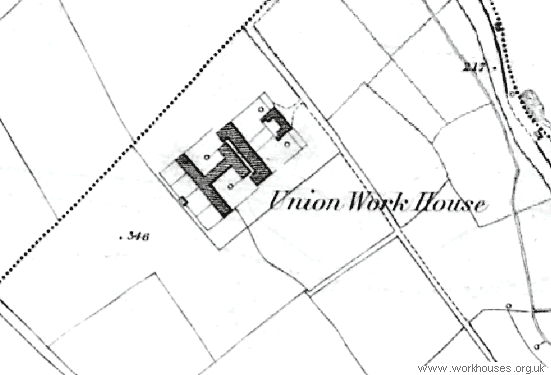
Mallow workhouse site, 1841.
The buildings followed Wilkinson's typical layout. An entrance and administrative block at the east contained a porter's room and waiting room at the centre with the Guardians' board room on the first floor above.
The main accommodation block had the Master's quarters at the centre, with male and female wings to each side. A large two-storey block now stands on this site but this is believed to be a replacement building dating from 1936.
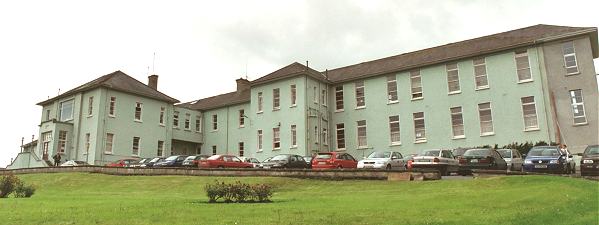
Mallow main block from the north-east, 2002
© Peter Higginbotham.
At the rear, a range of single-storey utility rooms such as bakehouse and washhouse connected through to the infirmary and idiots' wards via a central spine containing the chapel and dining-hall.
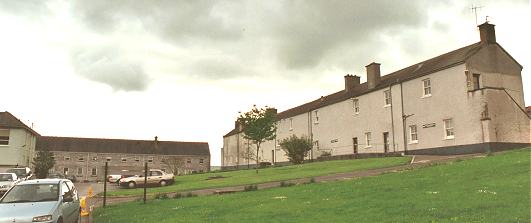
Mallow central spine and infirmary block from the north, 2002
© Peter Higginbotham.
During the famine in the mid-1840s, sheds were erected to accommodate 100 extra inmates. Fever patients were initially sent to hired premises at Doneraile pending the construction of a sixty-bed fever hospital at the north of the workhouse. The workhouse had its own burial ground at the west of the site.
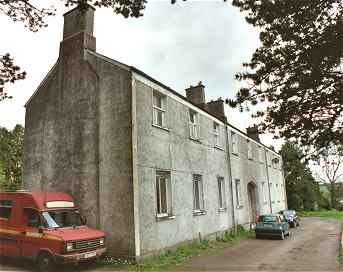
Mallow fever hospital from the south-east, 2002
© Peter Higginbotham.
The later layout of the site is shown on the 1903 map below:
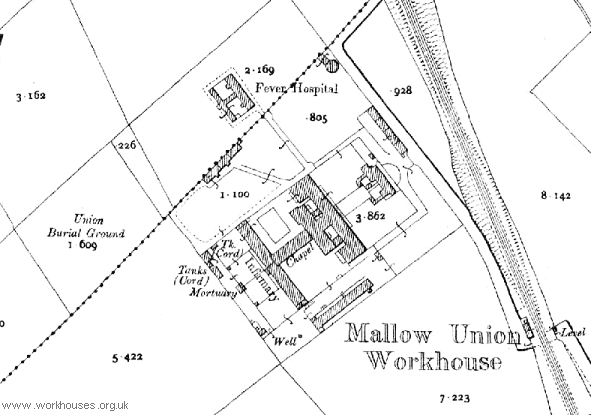
Mallow workhouse site, 1903.
In 1895, Mallow was visited by a "commission" from the British Medical Journal investigating conditions in Irish workhouse infirmaries. Their report found much to criticise, especially the "miserable" conditions in which the aged and infirm were housed. The size of the nursing staff was also criticised, with the suggested appointment of at least two trained nurses in the place of one untrained. It was recommended that a supply of hot water be provided for the infirmary, and that baths and lavatories be installed throughout. Further details are available in the full report.
Following the creation of the Irish Free State in 1922, the main workhouse building was redesignated as a County Home while the infirmary became a District Hospital. In 1927, it was reported that, since the reorganisation, no improvements had been carried out. There was no internal sanitary accommodation, and the water supply and bathing accommodation were bad. The female infirm were housed in a separate block at the side of the main building with lunatics in the basement, and with littleor no classification between them. On the male side, the accommodation for male lunatics was very bad and overcrowded.
The former workhouse site is now the home of Mallow General Hospital.
Records
Note: many repositories impose a closure period of up to 100 years for records identifying individuals. Before travelling a long distance, always check that the records you want to consult will be available.
- Cork City and County Archives, 33a Great William O'Brien Street, Blackpool, Cork. Holdings include: Board of Guardian Minute Books (1839-1911).
Bibliography
- Crossman, V (2006) Politics, Pauperism and Power in Late Nineteenth-century Ireland
- Gray, P (2009) The Making of the Irish Poor Law, 1815-43
- O'Connor, J (1995) The Workhouses of Ireland
Links
Unless otherwise indicated, this page () is copyright Peter Higginbotham. Contents may not be reproduced without permission.


